Edubuntu-menueditor
|
Size: 900
Comment: frist commit, listing what I need to do.
|
← Revision 19 as of 2010-09-15 17:53:27 ⇥
Size: 5527
Comment:
|
| Deletions are marked like this. | Additions are marked like this. |
| Line 1: | Line 1: |
| #title Menueditor and Profile manager | |
| Line 2: | Line 3: |
| = menueditor = * What is menueditor ? * Menueditor is an applications to create menu to be later able to apply them to groups. * Where to find it ? * The menueditor is part of the package '''edubuntu-menueditor''' and is found under '''Applications/Systems Tools/Edubuntu menu editor'''. |
<<TableOfContents(3)>> = Menu Editor = |
| Line 8: | Line 6: |
| * playing with sub-menus * add * edit * delete * moving * copy, and delete * playing items in submenu items * add * deleting * hiding * moving items around * saving your work. * limitation |
The Menueditor is a tool that creates menus that can be applied to users and groups with its profile manager. |
| Line 22: | Line 8: |
| == How to find it == | |
| Line 23: | Line 10: |
| = profilemanager = * What is profilemanager ? * Where to find it ? |
* The menueditor is part of the package '''edubuntu-menueditor''' and is found under '''Applications/Systems Tools/Edubuntu menu editor''' * Interface presentation {{attachment:Menueditor-interface.png}} * The interface is very simple, it consist of a 2 column tree-view * The left column contains the icons and entry names * The right one contains a check box to toggle between hide/show for the items. * Items in the tree-view have context menus available, depending on the items and where it comes from, you might have more option available in the context menu * A menu consist of 2 types of items: * Desktop entry, that usually launch application * Sub-menus, that can contain other sub-menu and desktop entry |
| Line 27: | Line 21: |
| * overview of the main window. * groups * menus * associations * import menus * naming the menu * delete menus from the system. |
== Working with sub-menus == |
| Line 35: | Line 23: |
| * adding associations * group-menu * menu-group * removing association *saving |
=== Adding a sub-menu to the menu === |
| Line 41: | Line 25: |
| * showing system groups * what are they |
* Sub-menus can be added anywhere in the menu tree, to create a new sub-menu, follow the following steps: 1.#1 decide where you want to create the sub-menu and right-click, 1. A context menu appear, click on '''Add Sub-menu''', {{attachment:Menueditor-add-submenu.png}} 1. A dialog box will appear and ask you for the name and a comment for the menu {{attachment:Menueditor-submenu-name-dialog.png}} * The name will be displayed as the submenu name * The comment will appear when the mouse stays over the menu for a while 1. click on '''OK''' to create then menu entry. {{attachment:Resulting-submenu.png}} == Editing Menus == It's only possible to edit and delete sub-menus you have created, copied or moved. Context menu activate items only for action you can perform. * Editing a name or comment * Select the sub-menu you want to edit, do a right-click and select '''Edit Sub-menu'''. * A dialog box will appear containing the current menu name. Change the appropriate value and press '''OK''' {{attachment:Menueditor-rename-dialog.png}} * The interface now shows the new name for the menu. {{attachment:Resulting-rename.png}} * Deleting or Hiding items * Difference between deleting and hiding * Deleting an item can only be done for created or copied item * Hiding item can be done to any item * Usualy you will want to delete items you have created or moved, and hide all other items * To delete an item, simply right-click on the item you want to delete and select the '''Delete Item''' from the sub menu * To hide an item, simply uncheck the checkbox on the right * When hiding a sub-menu, all items in the sub-menu are hidden /!\ If an application that goes in this sub-menu is installed afterward the item will show up in the menu === Copying/Moving an item === * Items in menu can be copied to another place, to do so simply drag and drop the item in the menu * Items in the tree cannot be moved, but can be copied and then hidden * This is the way the menueditor is used to add applications in custom sub-menu, simply select the item you want in your menu, drag it over your sub-menu and release it. The item will appear into the sub-menu * Saving your work * Select '''File/Save''' from the menu * Browse where you want to save your file and enter a name, you will need to add the .tar.gz extension as well = Profile manager = Profile manager is used to link profile made with Menueditor to group of users. == How to find it == * Profilemanager is part of the package '''edubuntu-menueditor''' and is found under '''System/Administration/Edubuntu menu editor - Profile Manager''' * User Interface {{attachment:Profilemanager-interface.png}} * The interface is quite simple * It consist of 3 lists of element: '''Groups''', '''Menus''' and '''Group and menu associations''' == Groups == * Groups contain the list of groups present on the system * You can show system group (group with a ''gid'' lower then 1000), by selecting '''View/Show system group''' from the menu == Menus == === Importing menus === * To import a menu, simply do a right-click in the Menus area * Select '''Import new profile''', navigate to your previously created menus * Enter the name of the menu and press '''Ok''', the menu appear in the list of menus and files are created in '''/etc/edubuntu-menueditor/''' /!\ Only alpha-numeric, dash (-), underscore (_) and dot (.) are allowed naming of menus, any other character will be replaced by an underscore. === Deleting menus from the system === * Right-click on a menus from the menu list * Select '''Delete Item''' from the context menu /!\ Be careful not to delete used menus == Association == === Adding associations === * Associations mean to link a menu with a group * Simply drag a group and drop it over a menu * Dragging a menu over a group will work too * You will need to save to activate it, select '''File/Save''' from the menu === Removing an association === * Right-click on the association you want to delete and select '''Remove''' from the context menu, then confirm you want to delete the configuration file under '''/etc/deskop-profile/'''. * You don't need to save at this point. The file is deleted when you confirm After this, when a user that is part of the group logs in, the menu should be updated |
Contents
Menu Editor
The Menueditor is a tool that creates menus that can be applied to users and groups with its profile manager.
How to find it
The menueditor is part of the package edubuntu-menueditor and is found under Applications/Systems Tools/Edubuntu menu editor
- Interface presentation
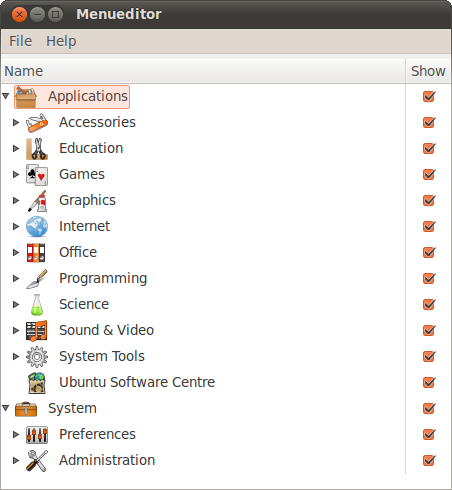
- The interface is very simple, it consist of a 2 column tree-view
- The left column contains the icons and entry names
- The right one contains a check box to toggle between hide/show for the items.
- Items in the tree-view have context menus available, depending on the items and where it comes from, you might have more option available in the context menu
- A menu consist of 2 types of items:
- Desktop entry, that usually launch application
- Sub-menus, that can contain other sub-menu and desktop entry
Working with sub-menus
Adding a sub-menu to the menu
- Sub-menus can be added anywhere in the menu tree, to create a new sub-menu, follow the following steps:
- decide where you want to create the sub-menu and right-click,
A context menu appear, click on Add Sub-menu,
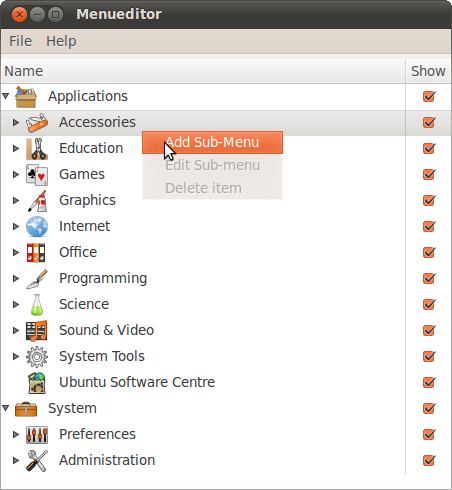
- A dialog box will appear and ask you for the name and a comment for the menu
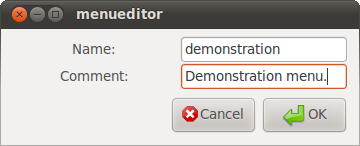
- The name will be displayed as the submenu name
- The comment will appear when the mouse stays over the menu for a while
click on OK to create then menu entry.
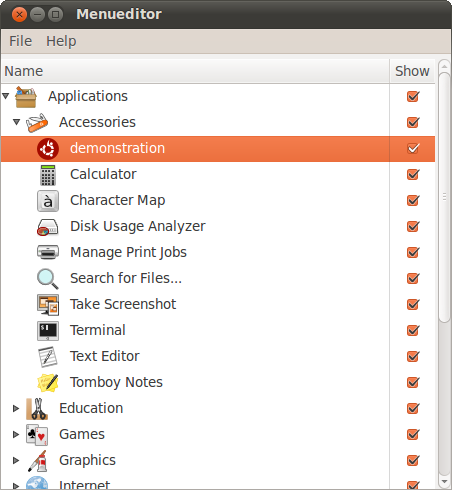
Editing Menus
It's only possible to edit and delete sub-menus you have created, copied or moved. Context menu activate items only for action you can perform.
- Editing a name or comment
Select the sub-menu you want to edit, do a right-click and select Edit Sub-menu.
A dialog box will appear containing the current menu name. Change the appropriate value and press OK
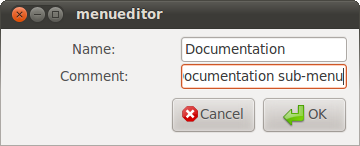
- The interface now shows the new name for the menu.
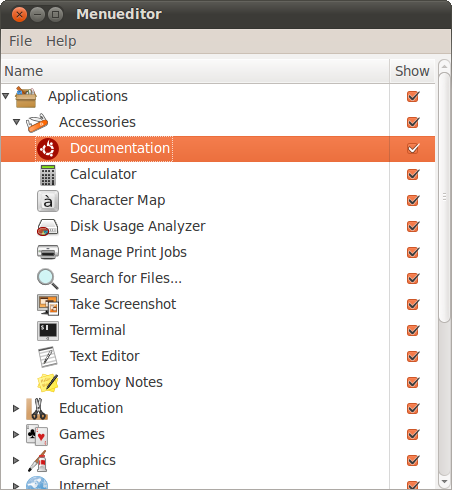
- Deleting or Hiding items
- Difference between deleting and hiding
- Deleting an item can only be done for created or copied item
- Hiding item can be done to any item
- Usualy you will want to delete items you have created or moved, and hide all other items
To delete an item, simply right-click on the item you want to delete and select the Delete Item from the sub menu
- To hide an item, simply uncheck the checkbox on the right
- When hiding a sub-menu, all items in the sub-menu are hidden
 If an application that goes in this sub-menu is installed afterward the item will show up in the menu
If an application that goes in this sub-menu is installed afterward the item will show up in the menu
- When hiding a sub-menu, all items in the sub-menu are hidden
- Difference between deleting and hiding
Copying/Moving an item
- Items in menu can be copied to another place, to do so simply drag and drop the item in the menu
- Items in the tree cannot be moved, but can be copied and then hidden
- This is the way the menueditor is used to add applications in custom sub-menu, simply select the item you want in your menu, drag it over your sub-menu and release it. The item will appear into the sub-menu
- Saving your work
Select File/Save from the menu
- Browse where you want to save your file and enter a name, you will need to add the .tar.gz extension as well
Profile manager
Profile manager is used to link profile made with Menueditor to group of users.
How to find it
Profilemanager is part of the package edubuntu-menueditor and is found under System/Administration/Edubuntu menu editor - Profile Manager
- User Interface
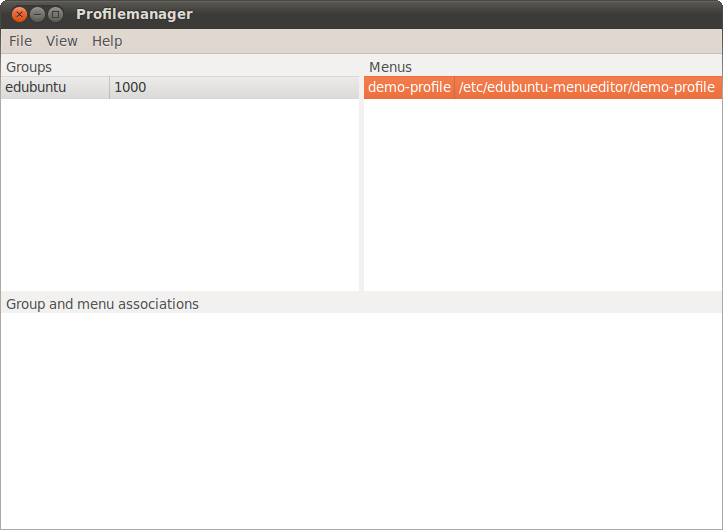
- The interface is quite simple
It consist of 3 lists of element: Groups, Menus and Group and menu associations
Groups
- Groups contain the list of groups present on the system
You can show system group (group with a gid lower then 1000), by selecting View/Show system group from the menu
Menus
Importing menus
- To import a menu, simply do a right-click in the Menus area
Select Import new profile, navigate to your previously created menus
Enter the name of the menu and press Ok, the menu appear in the list of menus and files are created in /etc/edubuntu-menueditor/
 Only alpha-numeric, dash (-), underscore (_) and dot (.) are allowed naming of menus, any other character will be replaced by an underscore.
Only alpha-numeric, dash (-), underscore (_) and dot (.) are allowed naming of menus, any other character will be replaced by an underscore.
Deleting menus from the system
- Right-click on a menus from the menu list
Select Delete Item from the context menu
 Be careful not to delete used menus
Be careful not to delete used menus
Association
Adding associations
- Associations mean to link a menu with a group
- Simply drag a group and drop it over a menu
- Dragging a menu over a group will work too
You will need to save to activate it, select File/Save from the menu
Removing an association
Right-click on the association you want to delete and select Remove from the context menu, then confirm you want to delete the configuration file under /etc/deskop-profile/.
- You don't need to save at this point. The file is deleted when you confirm
After this, when a user that is part of the group logs in, the menu should be updated
Edubuntu/Documentation/Edubuntu-menueditor (last edited 2010-09-15 17:53:27 by gw-sherb)